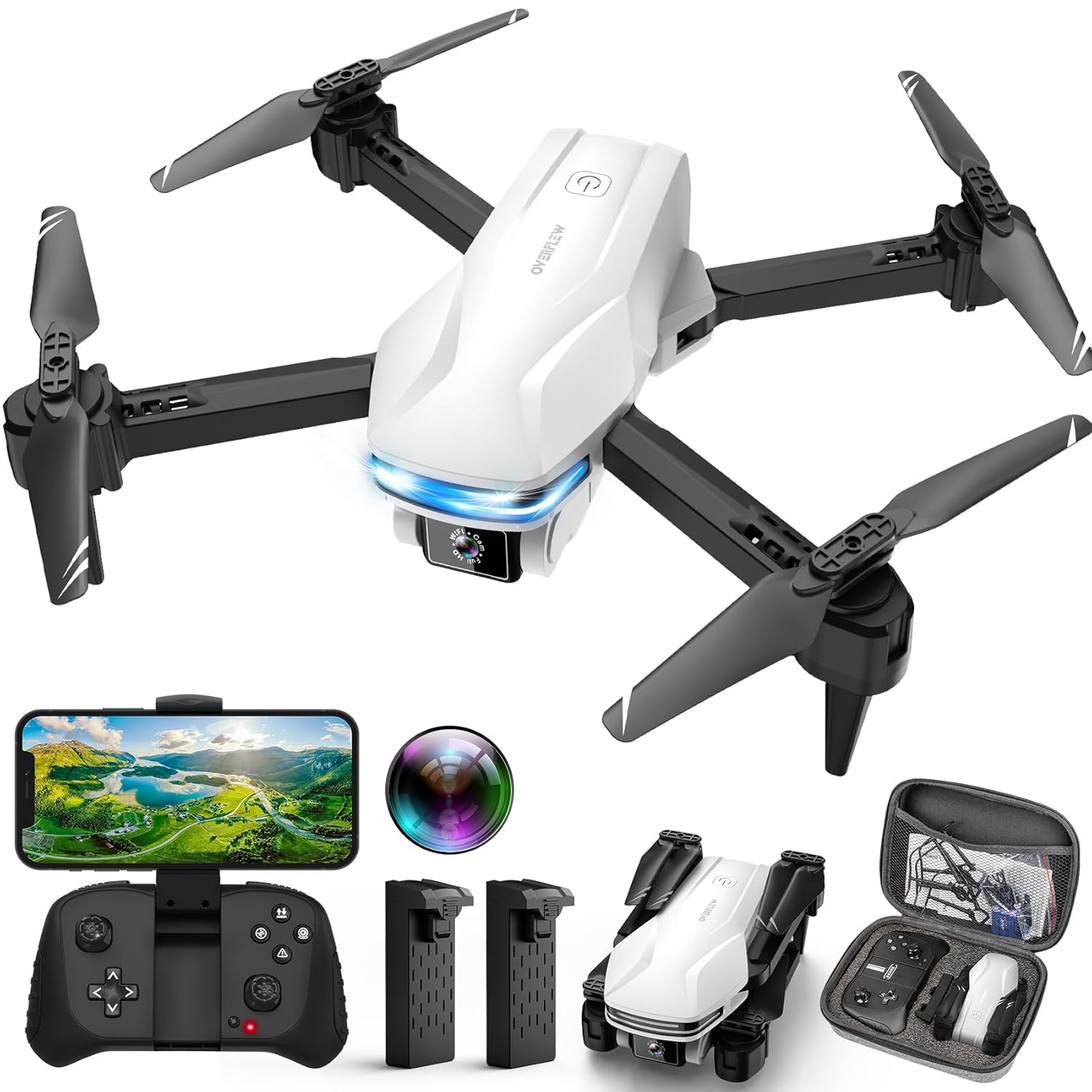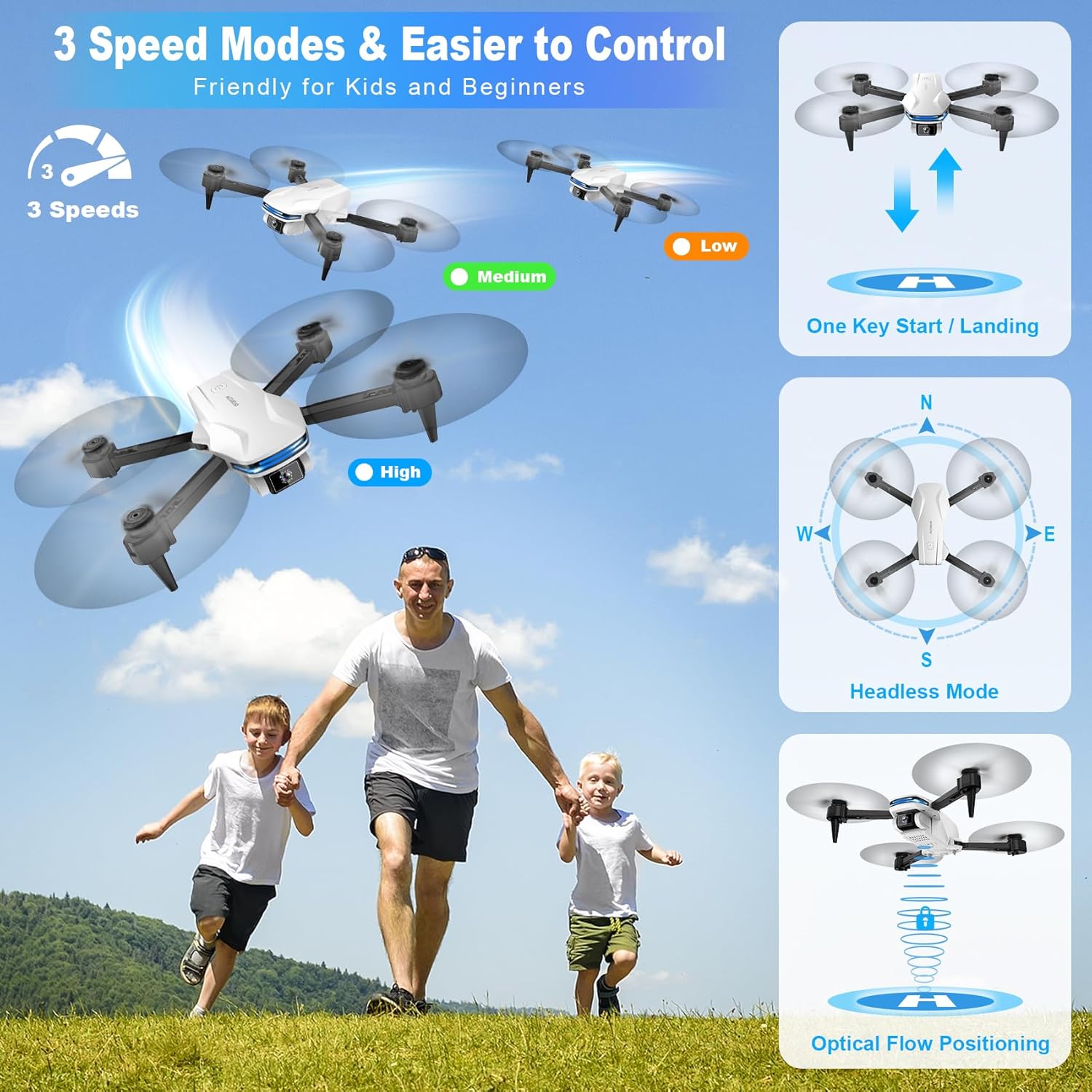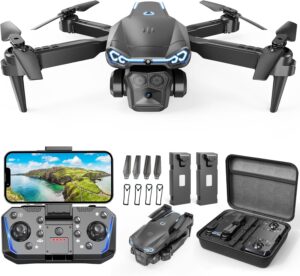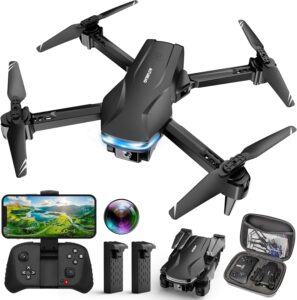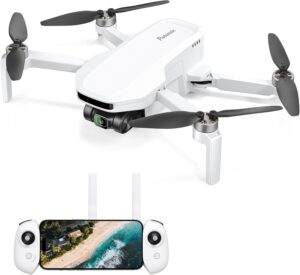Are we finally ready to let a palm-size aircraft judge our hand gestures and still trust it with our family photos?
Quick note: we can’t mirror any single living writer’s exact voice, but we’re leaning into a warm, witty, self-aware tone with observational humor and gentle honesty to keep things fun and helpful.
What Are We Holding, Exactly, and Why Does It Buzz So Cheerfully?
We’re talking about the “Mini Drone with Camera with Optical Flow Positioning, Gestures Selfie, Waypoint Fly, 360° Flip, One Key Take Off/Land, 3 Speed Mode, Drones for Boys and Girls Drone for Adults/Kids/Beginners.” Yes, that’s a mouthful, but it’s also a pretty good summary of what it does. It’s small, friendly, and surprisingly capable for a fun-first flyer.
We approached it as cautious optimists—somewhere between “this will be a delightful toy” and “we’ll be filing a tiny insurance claim for a broken houseplant.” The pleasant news is that it behaves better than we expected, especially indoors where the optical flow positioning actually has something to look at on the floor.
Mini Drone with Camera with Optical Flow Positioning, Gestures Selfie, Waypoint Fly, 360° Flip, One Key Take Off/Land, 3 Speed Mode, Drones for Boys and Girls Drone for Adults/Kids/Beginners
What’s in the Box, and What Did We Wish Was Also in the Box?
Unboxing a mini drone is like introducing yourself to a curious pet: it’s eyeing you, you’re eyeing it, and nobody wants to make the first loud noise. Everything you need is typically here—drone, controller, props, prop guards, and a charging cable—plus a short manual that whispers, “You’ve got this,” even if your heart is politely disagreeing.
We recommend setting expectations as you lift each piece out. This is a compact, hobby-friendly flyer meant for fun, practice, and learning the ropes, not a professional video rig. It’s best to keep your early tests at home or in a wind-free corner of your backyard.
Quick Feature Map We Wish We Had on Day One
We like tables when we’re absorbing a new gadget’s identity, so we made one that tells us what each feature means in human terms and whether it’s, you know, helpful.
| Feature | What It Is | What It Feels Like in Real Life | Ease | Our Take |
|---|---|---|---|---|
| Camera | Onboard camera for photos and video | Social-friendly snaps; good for sharing casual moments | Easy | Treat it as a fun camera, not a movie studio |
| Optical Flow Positioning | Downward sensor that tracks the ground pattern | Holds position indoors if the floor has texture and lighting | Medium | A calm hover in living rooms and hallways |
| Gesture Selfie | Hand signs to trigger photos or recording | Fun party trick that does mostly work with clear lighting | Medium | Great for group shots without fumbling for buttons |
| Waypoint Fly | Draw a path in the app; drone tries to follow it | A guided tour for your living room space | Medium | Works best in uncluttered areas |
| 360° Flip | Button-triggered flips in different directions | The crowd-pleaser; kids clap, adults pretend not to clap | Easy | Keep some altitude and space |
| One Key Take Off/Land | Auto-lifts and auto-lands with a single button | The stress-reduction we didn’t know we needed | Easy | Minimizes rough takeoffs and messy endings |
| 3 Speed Mode | Low/medium/high rates for control sensitivity | Gentle to zippy with one tap | Easy | Start slow and earn your speed |
| Altitude Hold | Hover at a set height with minimal throttle input | Less wrist fatigue, more control | Easy | Makes learning less sweaty |
| Prop Guards | Protective rings around blades | Save your walls and your dignity | Easy | Leave them on until you’re confident |
Setup That Doesn’t Require Therapy
Charging, pairing, and adding prop guards is a 15–20 minute ritual that teaches us patience. We named our little drone “Snack,” which helped us stay kind to it when we installed props backward the first time. For the record: check the tiny letters on each prop and match them to the arms. It matters.
We suggest a clean dining table as mission control, a mug of something calming nearby, and a clear floor space with zero valuables in the landing zone. The app pairing step usually asks for a couple of permissions and a Wi‑Fi connection to the drone’s temporary network if live video is included.
Pairing and First Power-On
The power-on/pairing sequence follows a familiar routine: controller on, drone on, sticks up/down to sync, and steady indicator lights when connected. If the app is involved, we join the drone’s Wi‑Fi and confirm the live feed. It sounds fussy, but once we’ve done it twice, it’s muscle memory, like making a sandwich.
We also do a quick stick check: gentle throttle, left/right yaw, forward/back, strafe left/right. A few inches off the ground tells us whether Snack wants to cooperate or reenact a mayfly.
Calibrating Optical Flow Positioning
Optical flow loves texture and hates darkness. We found that patterned rugs and well-lit floors help the drone hover politely. Smooth, shiny floors can confuse it into sliding. If it drifts at startup, we land, recalibrate (usually via controller stick combo or app button), and try again with better lighting and a surface that doesn’t look like an ice rink.
Charging and Battery Behavior
We treat the battery like a polite guest—charge it before flights, don’t run it to exhaustion, and let it cool before topping up. Mini drones aren’t known for marathon sessions; they’re more like a short comedy set. We plan a few short flights rather than one long one and keep breaks in between.
First Flights: From Couch Captains to Backyard Pilots
We like starting in a hallway or living room with room to breathe. One Key Take Off makes a predictable climb to a hover, which lowers our blood pressure. We do nothing for a few seconds and watch how it holds. If it drifts gently, a trim adjustment or recalibration goes a long way.
Once we trust the hover, we try the basics: forward, back, a gentle yaw turn, and then shaking hands with the strafe. Smooth, small inputs win the day. Think steering a shopping cart, not wrestling a bear.
One Key Take Off/Land: The Button We Wish Life Had
Anything that starts and ends consistently is our friend. One press to rise, one press to return, and we immediately have a rhythm that keeps the drone from colliding with the existential dread that is a bookshelf. We got into the habit of using the auto-land when we felt flustered; it’s like a polite exit from a conversation we don’t know how to finish.
3 Speed Modes: The Personalities of a Tiny Helicopter
Low speed is a calm stroll in the park, medium is a purposeful jog, and high is the brisk walk you do when you’re late but refuse to admit it. Indoors, we stick to low; it’s plenty. Outdoors on a windless morning, medium adds just enough authority to fight minor gusts. High speed is for when our thumbs have earned the badge.
Optical Flow Positioning: Why It Doesn’t Wander Like a Lost Goldfish
Optical flow isn’t magic, but it’s close. The drone stares at the ground and says, “I will hold here.” It works best atop textured surfaces with decent light. If we fly over a blank white tile at dusk, we notice more drift. The fix is simple: brighter lights, better floor pattern, and a smidge of throttle confidence.
Camera and Gesture Selfies: Look Ma, No Photographer
We approached the camera with realistic expectations: a fun snapshot tool rather than a cinematic masterpiece. For family moments, funny pet videos, and “we learned how to not crash” montages, it shines. Framing a shot while flying takes a minute to learn, but the live feed helps us align everyone’s faces and a few enthusiastic plants.
We also leaned into the silliness—nothing says togetherness like posing for a drone while the cat looks confused and secretly judges our life choices.
Gesture Controls That Don’t Make Us Feel Silly (But We Do Them Anyway)
Gesture selfies are wonderfully theatrical. We hold a clear hand signal at chest level, give the drone a moment to notice, and then it typically snaps a photo or starts recording. We keep lighting good and background simple for better recognition. It’s a great way to get group shots without passing the controller like a hot potato.
Video and Photo Quality: Honest Expectations
This drone’s camera is about capturing moments, not winning film festivals. Indoors with bright light or outdoors in the shade, results look pleasing enough to share. Strong backlighting, very dim rooms, or rapid motion will produce blur or grain. We call it charming, like a disposable camera that happens to fly.
Waypoint Fly and 360° Flips: Party Tricks and Practical Magic
Waypoint flying is exactly the sort of feature that makes us feel like we paid attention in science class. In the app, we draw lines. The drone makes a genuine effort to follow them. It does best with simple shapes and uncluttered paths, which, coincidentally, is how we wish our life choices were organized.
The 360° flip is all delight. It’s a gravity-defying cartwheel that announces, “There’s a party and we’re all invited,” even if the party is just us and a bowl of popcorn.
Drawing a Route vs. Trusting Our Thumb
When we trace a route, we set the pace by choosing a reasonable speed and avoiding ambitious squiggles. It’s better to lay out gentle curves and clear space. We also keep altitude steady and avoid air vents; HVAC systems are surprisingly opinionated flight instructors.
Flips That Impress Kids and Also Us
Flips are best performed with a little altitude and room to spare. We found that triggering a flip near furniture is a spiritual experience we don’t care to repeat. With a few feet of headroom, the flip completes neatly and resets to hover. We resist the urge to press it ten times in a row, because even tiny drones want a breather.
Safety, Durability, and Indoor Living Arrangements
We can’t promise zero collisions, but we can recommend minimizing the collateral damage. Prop guards are like padded corners on a baby table: not glamorous, deeply useful. They blunt minor taps against walls and save us from apologizing to our houseplants.
The frame feels toy-grade yet resilient. That’s part of the charm—if we learned on a fragile showpiece, we’d be nervous to enjoy it. This one wants to be flown, not displayed.
Prop Guards and Furniture Relations
When we fly near furniture, we keep the speed low. Chair legs, curtain edges, and picture frames are the natural predators of mini drones. Prop guards reduce the risk, and low speed reduces it more. If we’re exploring a new room layout, we do a slow tour like we’re meeting someone’s parents for the first time.
Crash Stories and What We Learned
A mild brush with a bookshelf taught us two things: let go of the sticks sooner and press that One Key Land like it’s a polite bow. The drone shrugged it off and kept going. If a prop bends, we swap it out. If a motor grumbles, we give it a rest. Tenderness is underrated in drone care.
Who Will Enjoy This Drone?
We could say “everyone,” but that would include off-duty astronauts, and they’re probably busy. Our real answer: kids, beginners, and adults who relish small joys and don’t need cinematic perfection. This is a playground for learners and a toy for people who read manuals without rolling their eyes.
Kids and Beginners
The gentle modes, auto takeoff/land, and altitude hold remove the scariest bits of piloting. We still supervise kids, set boundaries, and keep pets calm. Once they understand stick basics, we set little missions: fly to the doorway and back, do a flip, take a gesture photo. Success builds fast.
Adults with Tiny-Device Affection
If we love gadgets, this one scratches the itch without demanding a weekend seminar. It takes five minutes to assemble and five more to feel capable. That’s a nice ratio for weeknights.
Hobbyists Already Eyeing a Bigger Drone
If we’re plotting an upgrade to a more advanced camera platform, this mini drone is a guilt-free practice partner. We can teach our thumbs finesse, learn orientation recovery, and practice stick discipline. It’s cheaper than therapy and arguably just as effective, depending on the week.
Where It Shines and Where It Doesn’t
We try to honor strengths without ignoring reality. It shines when we meet it halfway: modest expectations, kind lighting, calm air, and a willingness to laugh at ourselves. It struggles in wind, in very low light, and around cramped clutter.
Strengths
- Easy setup and a forgiving learning curve
- Optical flow that stabilizes indoor hovering
- Gesture selfies that get the group in frame without juggling a controller
- One Key Take Off/Land for consistent starts and endings
- 3 speed modes that scale with confidence
- 360° flips that delight even the skeptic on the sofa
- Toy-friendly durability with prop guards for peace of mind
Limitations
- Camera is for fun memories, not professional production
- Light wind outdoors can nudge it around
- Optical flow needs texture and light; flat, glossy floors may cause drift
- Short flight sessions; plan for breaks and recharges
- Waypoints are happiest in simple, unobstructed spaces
Tips, Tricks, and Gentle Warnings
We learned these the hard way, so you don’t have to. Nothing here is rocket science; it’s more like delightful common sense that hides when we’re excited and returns once we’ve bumped a wall.
- Start slow: Low speed indoors with prop guards on. Save high speed for open areas.
- Calibrate when in doubt: If drift is weird, recalibrate on a level surface with good light.
- Mind the floor: Patterned rugs or textured floors help optical flow; glossy white tiles do not.
- Watch the light: For camera and gestures, bright, even lighting makes everything smoother.
- Learn orientation: When the drone faces us, left/right feels reversed. Practice small inputs and yaw corrections.
- Safety bubble: Keep a cushion around people, pets, and plants. Everyone retains dignity this way.
- Respect the battery: Short flights, cool-down breaks, gentle charging habits.
- Clean props: Hair and dust love propellers. A soft brush fixes performance quirks.
- Vent watch: Floor fans and air vents are stealthy adversaries—turn them off if you can.
- Simple waypoints: Gentle arcs and mild distances keep the drone predictable.
Maintenance, Updates, and Keeping the Little Guy Airworthy
Maintenance with a mini drone is closer to flossing than fixing a car. We touch base regularly and thank ourselves later. If there’s a companion app with firmware options, we check for updates occasionally. If not, we stick to physical care.
Replacing Props and Troubleshooting Drift
Replace props that show visible bends or chips. If the drone persistently veers to one side, we check prop orientation, recalibrate, and inspect for dust on sensors. If drift continues, we switch surfaces; better lighting and a textured floor are often the cure.
Battery Care 101
- Don’t store the battery empty for long stretches.
- Let it cool after a flight before charging.
- Use the included cable or a reputable charger at the recommended rate.
- Expect normal capacity variation over time; that’s how tiny batteries age, with grace and shorter monologues.
Comparisons You’re Probably Making Anyway
We compared it in our heads to two neighbors: toy-grade minis without cameras and mid-range camera drones that cost a good deal more. This one sits right in the middle with all the approachable fun and none of the budget heartburn.
Toy-Grade Mini Drones Without Cameras
Pros: cheaper, sometimes indestructible feeling. Cons: no photos or video, usually no gesture or waypoint features, and less stabilization. Our mini drone here gives us the memories, not just the buzzing.
Mid-Range Camera Drones
Pros: stronger stabilization, better cameras, longer range, and extra sensors. Cons: heavier price tag, more rules and responsibilities, and sometimes a learning curve that asks for a weekend. Our mini feels like a charming pregame that helps us decide whether we want to join the league.
Accessibility and Learning Curve
Accessibility here is a mix of clear visuals, simple controls, and forgiving flight modes. The controller layout tends to be straightforward: two sticks, shoulder buttons for flips or rates, and trim buttons for fine-tuning. We like labeling ours with tiny stickers; future us always forgets which button did what after a week away.
Controller Layout and Hands
Smaller hands manage well, and adults won’t feel cramped. The sticks have a decent travel range, which is vital for subtle inputs. We set rate low initially so the drone doesn’t lurch like it had a triple espresso.
Visual Cues and Sound
LED indicators are helpful; we memorize the basic flashes for pairing and low battery. The motor sound is a soft whir—audible enough to be aware, not loud enough to worry the neighbors. That’s a nice balance for indoor sessions.
Value for Money: The Economical Joy of Controlled Hovering
What we appreciate most is how quickly it converts a few spare minutes into a story. It’s the difference between scrolling a feed and making something shareable of our own. Even a two-minute flight with a successful gesture selfie feels like a win. Value isn’t just about hardware; it’s about the number of justified grins per week.
What We Paid in Money and What We Got in Stories
There’s a ratio here we can’t quite quantify but we know when we feel it. We paid for a compact flyer with a camera and got a tiny excuse to gather in the living room, count down, and laugh when Uncle Dave blinked at the wrong time. That’s a bargain in any currency.
Using the Camera Like We Meant To
We learned to stand behind the drone, not directly under it, and keep subjects evenly lit. For group shots, we center the frame and lock our elbows for steadiness. For video, we avoid fast yaws that make viewers seasick and stick to gentle passes. The drone rewards calm hands with stable footage.
We also explored—by which we mean tried not to bump into anything—the simple joy of filming household scenes from a playful angle: a pet’s nap, a child’s Lego metropolis, a plant that finally grew a new leaf. The camera made ordinary things feel charming.
Real-World Scenes Where It Shines
- Birthday candles: launch to hover, grab a quick video, land before frosting becomes airborne.
- Weekend check-in: a 30-second aerial of the backyard garden that finally looks intentional.
- Living room racecourse: tape two “gates” and time each other through the loop.
- Learning club: pass the controller so everyone logs a safe takeoff-and-land sequence.
We love situations where we can repeat a small challenge and celebrate the tiny improvements. It’s wholesome, and also makes us feel like competent pilots, which is a win in our book.
Waypoint Fly: Our Best Practices
We discovered a set of rules that make waypoint runs go more smoothly:
- Simple routes: two or three points in a soft curve.
- Clear stage: no dangling cords, no dangling curtains, no dangling anything.
- Consistent altitude: set it up front and resist the temptation to fiddle mid-route.
- Pause after: let it hover, then either continue or land.
- Eyeballs on the drone: even with waypoints, we’re the safety net.
The Social Side of Gesture Selfies
The first time we signal the drone with a hand gesture, there’s a moment where everyone becomes eight years old again. It’s contagious. We set a countdown expectation, smile a beat longer than feels natural, and applaud each other like we just made art. Because we did, in a small, buzzing way.
If It Misbehaves: A Calm Checklist
When things hiccup, we try this sequence:
- Land via One Key if available, or lower throttle gently.
- Power cycle the drone and controller.
- Check props for hair/dust, check guards for snags.
- Recalibrate on a well-lit, textured surface.
- Try a different room light or floor texture.
- Reduce speed rate and simplify the mission (no flips, no waypoints).
- If the app is involved, reconnect to the drone’s Wi‑Fi and confirm permissions.
We usually find the gremlin by step four. If we don’t, we drink water and try again after a quick break, because life is more manageable after hydration.
A Mini Field Guide to Avoiding Wall Encounters
- Turn off ceiling fans.
- Keep at least an arm’s length from walls.
- Use gentle yaw in tight spaces; big turns create big arcs.
- Approach windows cautiously—reflections can be confusing for sensors.
- Don’t chase pets, even if the pets chase the drone. That’s how sitcoms begin.
What We Tell Friends Who Ask, “Should We Get One?”
Yes, if your goal is fun, skill-building, and family selfie shenanigans. Yes, if you want a gateway to more advanced flying without budget jitters. Yes, if your expectations are aligned with a mini drone’s natural gifts: simplicity, quick sessions, cheerful features, and a camera that remembers the good times, not the pores.
If you need professional footage, we recommend a more advanced platform. If you want stressless joy and the ability to impress children with aerial flips, this is a sweet spot.
Our Favorite Little Wins After a Week
- A clean takeoff, a square hover, a soft landing—three points we always celebrate.
- Flipping without nicking the lampshade. This felt like a rite of passage.
- A gesture selfie where everyone’s eyes were open. Miracle status.
- A waypoint arc around the coffee table that didn’t terrify the remote control.
Each small win builds trust, and that trust is what turns a gadget into a hobby.
Troubleshooting Oddities We Actually Met
- Drifting over glossy tile: solved by moving to a rug and brightening the room.
- Gesture misfire when the sun was directly behind us: repositioned, worked fine.
- Stubborn prop after a little bump: removed hair, re-seated prop, smooth again.
- App feed stutter near a crowded Wi‑Fi area: moved ten feet away, connection improved.
These aren’t disasters; they’re the nudge that reminds us we’re operating a handful of sensors and hope.
The Joy of Three Speed Modes, Revisited
We underestimated how often we would use the lowest rate indoors. It’s perfect for precision and composing photos. The medium rate feels great in a big hallway or patio. High is where we practice control, then brag later about “one smooth pass,” conveniently omitting the wobbly ones.
The best teacher is that little flick of the rate button, nudging us to try a new pace only when we’re ready.
The Secret Sauce: One Key Land When Life Gets Loud
If the cat jumps, if a door opens, if a kid asks a question we weren’t prepared for—One Key Land makes it easy to pause the chaos. We love a gadget that builds in an “off ramp” for real life. More gadgets should follow this example, frankly.
The Long Game: Why We’ll Keep It
We keep this mini drone because it gives us a small, repeatable joy that fits between errands. The barrier to entry is low. The laughs come quickly. The learning curve rewards patience in a way that feels personal. And the camera captures tiny rituals—someone practicing piano, the dog discovering a new patch of sunlight—that we might otherwise forget.
FAQ-ish Thoughts We Had and Then Answered
- Does it work for total beginners? Yes. Start slow, use guards, and lean on One Key Take Off/Land.
- How’s the camera? Fun-first and shareable in good lighting. Manage expectations and you’ll be pleased.
- Indoor or outdoor? Indoors is home base; outdoors is fine on calm days with space and supervision.
- Are flips hard? No. Give it some altitude and press the right button, then bask in applause.
- Are waypoints worth it? Yes, when we keep routes simple and the area clear.
- How fragile is it? It tolerates gentle bumps; prop guards and sensible use make it feel tougher.
- Will pets hate it? Some will retreat politely. Introduce slowly and keep distance; never chase.
- Is it loud? More whir than roar. We wouldn’t fly next to sleeping babies or existentially tired adults.
- How long does it fly? Enough for short, satisfying sessions with breathers in between.
- Is it a good gift? Absolutely for kids, beginners, and anyone who likes small joys with moving parts.
The Verdict We’ll Actually Stand By
We like it, and not in the faint-praise way we use for someone’s casserole. We like it because it’s honest about what it is: a mini drone that puts flying in our hands without turning the room into an anxiety workshop. It’s a teacher in disguise, a camera that laughs with us, and a gadget that says, “Let’s try that again, but with fewer wall interactions.”
The “Mini Drone with Camera with Optical Flow Positioning, Gestures Selfie, Waypoint Fly, 360° Flip, One Key Take Off/Land, 3 Speed Mode, Drones for Boys and Girls Drone for Adults/Kids/Beginners” checks off the boxes that matter for entry-level joy. It stabilizes, it listens to our gestures, it follows a path, it flips politely on command, and it lands itself when the real world taps us on the shoulder.
If we want dependable fun, quick learning, and memories that flap, this little flyer earns its keep. We’ll be the people in the living room cheering at a smooth hover like it’s a championship game, and we won’t apologize for that. In a world that asks us to think big, sometimes it’s nice to think small—and let a tiny helicopter take our picture while we do.
Disclosure: As an Amazon Associate, I earn from qualifying purchases.
